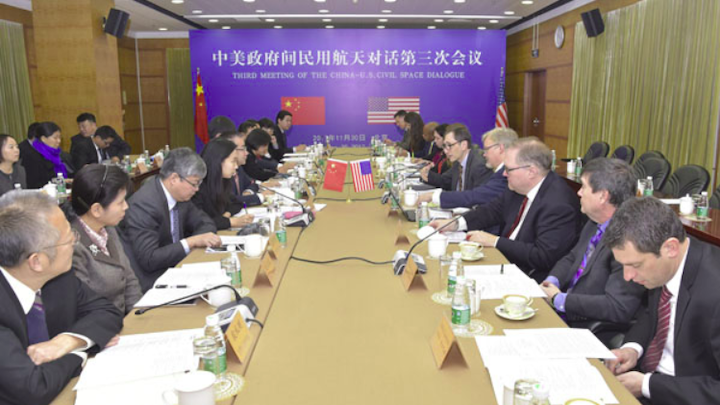22.01.2020

HELSINKI — U.S. and Chinese officials are working towards meeting for a bilateral Civil Space Dialogue around March in the first such discussion since 2017.
“The U.S. and China were not able to schedule a Civil Space Dialogue in 2019, but are in the planning stage for the U.S. to host the Dialogue during the first half of 2020,” a State Department official told SpaceNews.
No reason for the inability to schedule the meeting, earlier reported as to be expected in fall 2019, was offered. The U.S. and China last week agreed a ‘phase 1’ trade deal after nearly two years of trade hostilities.
Matthew Rydin, NASA press secretary and senior communications advisor, confirmed in an email to SpaceNews that the next U.S.-China Civil Space Dialogue, co-chaired for the U.S. by the State Department, is being planned in the March 2020 timeframe.
“The State Department is developing an agenda that will include areas of mutual interest concerning civil space exploration and science.”
The U.S.-China Civil Space Dialogue was established through the U.S.-China Strategic and Economic Dialogue in 2015, in order to enhance cooperation and transparency in the face of Congressional barriers to NASA engaging China. A first Civil Space Dialogue followed in Beijing later that year, with a second dialogue held in Washington in 2016 and a third and most recent in Beijing late 2017.
NASA is greatly restricted from bilateral collaboration with Chinese state entities by language first inserted into an appropriations bill in 2011. Similar language remains in place and is known as the Wolf Amendment, named for its author then-U.S. Rep. Frank Wolf (R-Va.).
Cooperation is allowed in the case that certification is provided from the FBI that such endeavors do not pose a national security risk and if Congress has been notified of the plan.
NASA-China cooperation, NewSpace concerns
On the potential of participation of NASA Administrator Jim Bridenstine, Rydin stated that, “traditionally, NASA’s participation in this meeting has been led by the Associate Administrator for International and Interagency Relations or Deputy Associate Administrator for International and Interagency Relations.
Rydin also confirmed that there have been no bilateral meetings between the NASA Administrator and the head of the China National Space Administration (CNSA) since the IAC 2018 in Bremen, Germany.
Bridenstine met with Zhang Kejian, administrator of the CNSA, on the sidelines of IAC in October 2018 and appeared with him in a panel discussion involving heads of multiple space agencies.
During that session Zhang said China was “very open” to working with a variety of international partners on lunar exploration.
Bridenstine noted greater sharing of data as an area of potential enhanced cooperation, in areas including science and also space situational awareness and space traffic management information.
The CNSA is not an equivalent body to NASA, but instead serves as the face of China’s space program to the outside world.
NASA and Chinese scientists collaborated in an attempt to coordinate the Chang’e-4 lunar far side landing in January 2019. NASA’s Lunar Reconnaissance Orbiter was unable to view the landing, but image the site during its next pass.
There are also concerns on the U.S. side with regard to the nascent Chinese commercial space sector. A 2014 central government policy shift opened sections of the space industry to private capital, leading to the proliferation of launch, small satellite and other companies.
U.S. NewSpace companies have expressed concern over artificial pricing and technology transfer, according to a report from Reuters.
Quelle: SN
